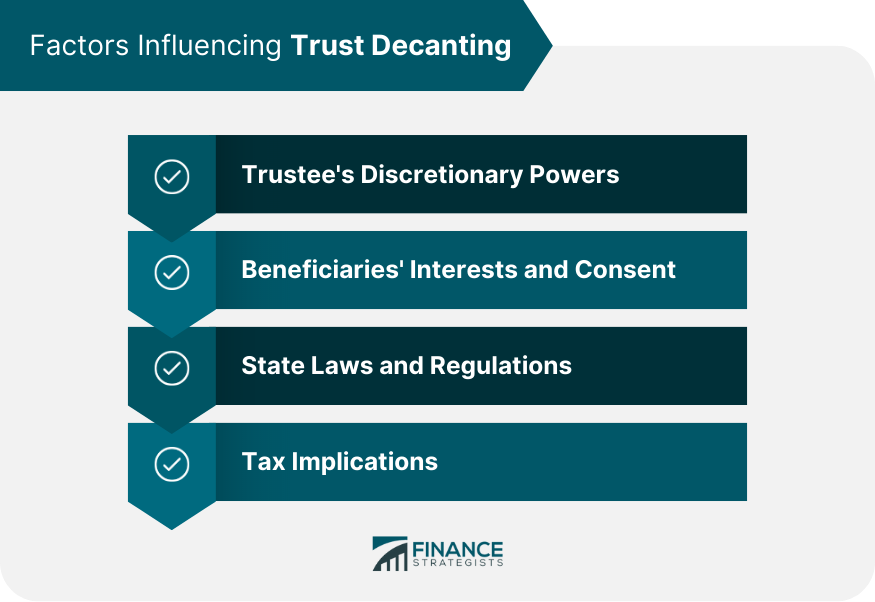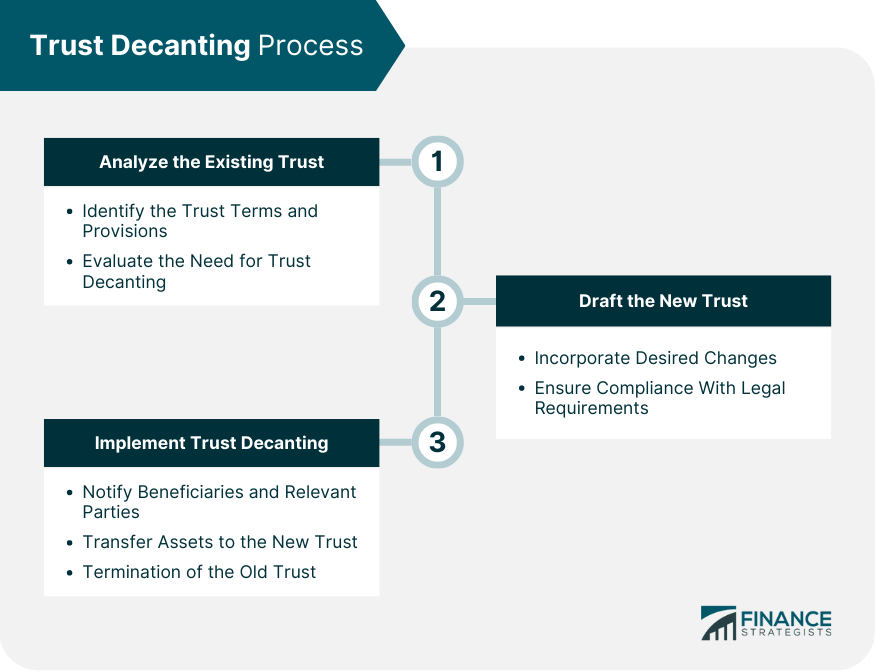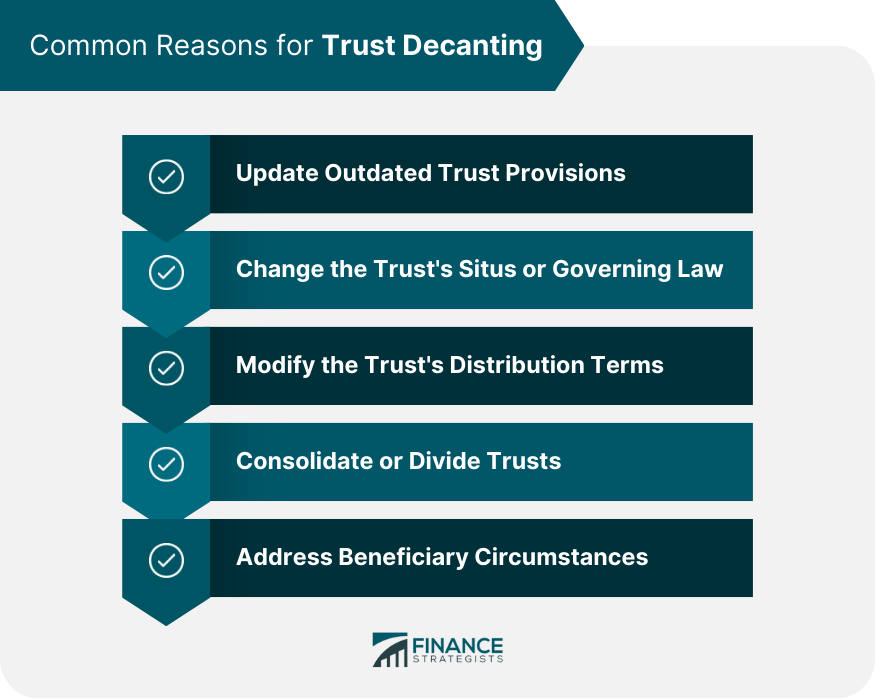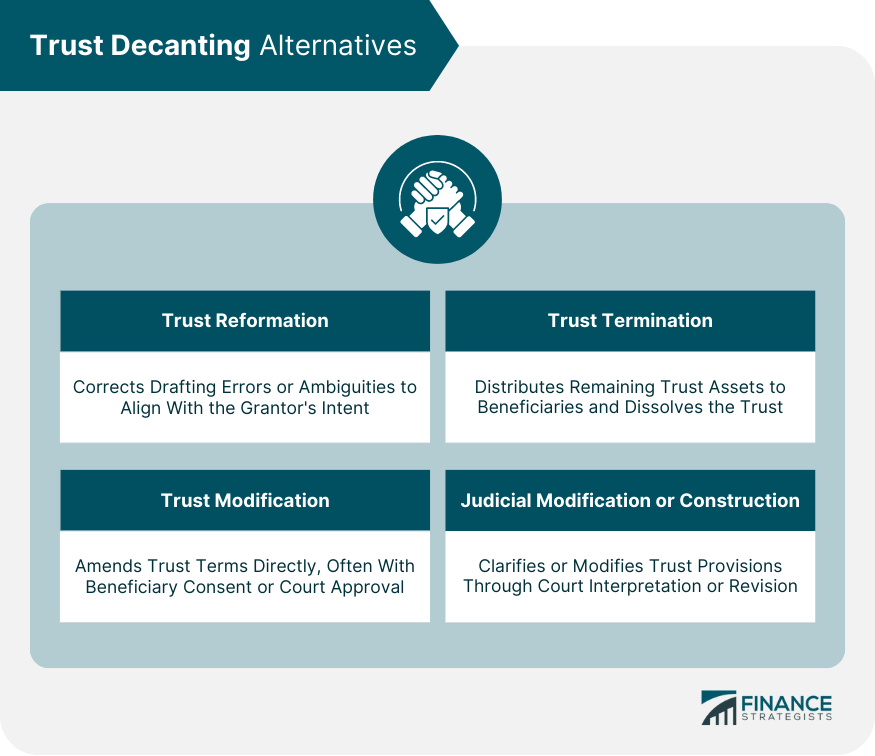Trust decanting refers to the process of transferring assets from one trust to another, often to modify or update the terms and provisions of the original trust. This technique provides flexibility in estate planning and enables adjustments to meet the changing needs of beneficiaries. The primary goal of trust decanting is to enhance the effectiveness of a trust by addressing outdated provisions or adapting to changing circumstances. Benefits include added flexibility, improved asset management, and the ability to address unforeseen situations without resorting to costly court proceedings. Trust decanting is governed by state laws, which vary in terms of permissible changes, requirements, and restrictions. It is crucial to understand the laws in the jurisdiction where the trust is administered to ensure a successful decanting process and avoid potential legal challenges. The extent of a trustee's discretionary powers plays a significant role in trust decanting. Generally, trustees with broad discretion have more latitude in decanting decisions, while those with limited authority may face restrictions or require court approval to make changes. The interests of beneficiaries are a crucial factor in trust decanting, as changes should not adversely affect their rights or entitlements. Obtaining consent from all beneficiaries can simplify the process and minimize the risk of disputes or legal challenges. State laws and regulations governing trust decanting differ widely, impacting the feasibility and process of decanting. Understanding the applicable laws is essential to determine if decanting is an option and to ensure compliance with specific requirements and limitations. Tax consequences of trust decanting can vary depending on the changes made and the jurisdictions involved. Careful planning and consultation with tax professionals can help mitigate potential adverse tax consequences and ensure compliance with relevant tax laws. Before undertaking trust decanting, trustees must thoroughly review the existing trust document to identify its terms, provisions, and any specific language regarding decanting. This step ensures that decanting is permitted and helps identify areas that may require modification. Trustees should assess the need for decanting by examining the trust's objectives, the beneficiaries' needs, and the potential benefits of updating the trust. This evaluation helps determine whether decanting is the most appropriate and effective solution for the trust's current circumstances. The new trust document should incorporate the desired changes while preserving the original trust's intent. Working with experienced legal counsel is crucial to ensure that the new trust accurately reflects the intended modifications and complies with applicable laws. Compliance with legal requirements is vital when drafting the new trust. This step involves adhering to the applicable state laws, observing any mandatory provisions, and ensuring that the new trust does not violate public policy or the rights of the beneficiaries. As part of the trust decanting process, trustees must notify all beneficiaries and any other relevant parties, such as co-trustees or trust protectors. Proper notification ensures transparency and provides an opportunity for objections or concerns to be addressed before the process is completed. The transfer of assets from the old trust to the new trust is a crucial step in the decanting process. This stage requires careful attention to detail and coordination with financial institutions to ensure the proper transfer of assets and minimize potential risks or delays. Once the assets have been successfully transferred to the new trust, the old trust is typically terminated. The termination process may involve formally dissolving the trust, providing final accounting to beneficiaries, and fulfilling any remaining obligations under the original trust. Decanting is often used to update outdated trust provisions that no longer serve their intended purpose or fail to address current beneficiary needs. This process allows for the modernization of trust terms, ensuring continued effectiveness and adaptability. Trust decanting can be employed to change the trust's situs (location of administration) or governing law to take advantage of more favorable laws or regulations. This strategy may provide increased asset protection, tax benefits, or enhanced privacy for the trust and its beneficiaries. Decanting allows for modifications to the trust's distribution terms to better align with the beneficiaries' needs or to address unforeseen circumstances. Changes may include adjusting the timing or manner of distributions, altering beneficiary interests, or adding or removing beneficiaries. Trust decanting can facilitate the consolidation of multiple trusts into a single trust for streamlined administration or the division of a single trust into separate trusts for greater flexibility and individualized management. Decanting can be used to address unique beneficiary circumstances, such as changing financial needs, disability, substance abuse issues, or family dynamics. By adapting the trust terms, decanting helps protect beneficiary interests and ensure continued support. Obtaining consent from all beneficiaries may prove challenging, particularly if they are numerous or difficult to locate. Disagreements among beneficiaries can also complicate the decanting process and potentially lead to disputes or litigation. Unanticipated tax consequences may arise from trust decanting, including triggering income, gift, or estate tax liabilities. Consulting with tax professionals and engaging in thorough planning is essential to minimize potential tax issues and maintain compliance. Conflicts of interest may emerge when the interests of beneficiaries and trustees diverge, potentially compromising the decanting process. Open communication, transparency, and professional guidance can help mitigate conflicts and ensure that trust modifications serve the best interests of all parties. Legal disputes may arise if the decanting process is contested, if beneficiaries challenge the trustee's authority or discretion, or if the trust's provisions are ambiguous. Involving legal counsel and following proper procedures can help prevent disputes and protect the interests of all parties involved. Trust reformation is a court-supervised process that corrects drafting errors or ambiguities in a trust document to better align with the grantor's intent. This option can address specific trust issues without the need for a full decanting process. Trust modification is another alternative that involves amending the trust terms directly, often with the consent of the beneficiaries or through court approval. This approach can provide a more straightforward means of making specific changes to a trust. In some cases, trust termination may be the most appropriate solution especially if the trust's objectives have been fulfilled or the trust is no longer serving its intended purpose. Termination involves distributing the remaining trust assets to the beneficiaries and dissolving the trust. Judicial modification or construction is a court-driven process that may be used to clarify or modify trust provisions in response to ambiguities, changed circumstances, or legal issues. This alternative often involves a judge interpreting or revising the trust terms to align with the grantor's intent or address unforeseen situations. Trust decanting is a process that provides flexibility and customization in estate planning. It enables trustees to modify outdated trust provisions or adapt to changing circumstances, benefiting beneficiaries by improving asset management and addressing unforeseen situations without resorting to costly court proceedings. However, trust decanting is governed by state laws and may involve potential risks and drawbacks, such as challenges in obtaining beneficiary consent, unforeseen tax consequences, conflicts of interest between beneficiaries and trustees, and legal disputes. Alternatives to trust decanting, such as trust reformation, modification, termination, or judicial modification or construction, may also be available depending on the specific circumstances. Proper evaluation, planning, and consultation with experienced legal and tax professionals are essential to ensure compliance with applicable laws, minimize risks, and protect the interests of all parties involved.What Is Trust Decanting?
Factors Influencing Trust Decanting

Trustee's Discretionary Powers
Beneficiaries' Interests and Consent
State Laws and Regulations
Tax Implications
Trust Decanting Process

Analyzing the Existing Trust
Identifying the Trust Terms and Provisions
Evaluating the Need for Trust Decanting
Drafting the New Trust
Incorporating Desired Changes
Ensuring Compliance with Legal Requirements
Implementing Trust Decanting
Notifying Beneficiaries and Relevant Parties
Transferring Assets to the New Trust
Termination of the Old Trust
Common Reasons for Trust Decanting

Updating Outdated Trust Provisions
Changing the Trust's Situs or Governing Law
Modifying the Trust's Distribution Terms
Consolidating or Dividing Trusts
Addressing Beneficiary Circumstances
Potential Risks and Drawbacks of Trust Decanting

Challenges in Obtaining Beneficiary Consent
Unforeseen Tax Consequences
Conflicts of Interest Between Beneficiaries and Trustees
Legal Disputes and Challenges to the Decanting Process
Trust Decanting Alternatives
Trust Reformation
Trust Modification
Trust Termination
Judicial Modification or Construction

Final Thoughts
Trust Decanting FAQs
Trust decanting is the process of transferring assets from an existing trust to a new trust with modified terms and provisions. It's important in estate planning as it provides flexibility and adaptability, allowing trusts to be updated to better serve the needs of beneficiaries and respond to changing circumstances.
Trust decanting involves creating a new trust and transferring assets, whereas trust modification involves amending the terms of the existing trust directly, and trust reformation is a court-supervised process to correct drafting errors or ambiguities. Trust decanting can offer more flexibility and a broader range of potential changes compared to the other methods.
Common reasons for trust decanting include updating outdated trust provisions, changing the trust's situs or governing law, modifying the trust's distribution terms, consolidating or dividing trusts, and addressing unique beneficiary circumstances.
Potential risks and drawbacks of trust decanting include challenges in obtaining beneficiary consent, unforeseen tax consequences, conflicts of interest between beneficiaries and trustees, and legal disputes or challenges to the decanting process.
An estate planning lawyer can help navigate the trust decanting process by providing expert guidance on legal requirements, drafting the new trust document, ensuring compliance with applicable laws, and minimizing potential risks or disputes. Their expertise is crucial for a successful and smooth trust decanting experience.
True Tamplin is a published author, public speaker, CEO of UpDigital, and founder of Finance Strategists.
True is a Certified Educator in Personal Finance (CEPF®), author of The Handy Financial Ratios Guide, a member of the Society for Advancing Business Editing and Writing, contributes to his financial education site, Finance Strategists, and has spoken to various financial communities such as the CFA Institute, as well as university students like his Alma mater, Biola University, where he received a bachelor of science in business and data analytics.
To learn more about True, visit his personal website or view his author profiles on Amazon, Nasdaq and Forbes.











